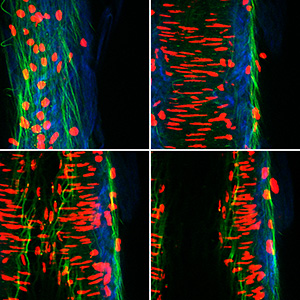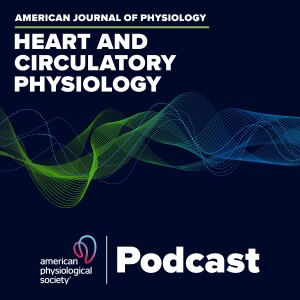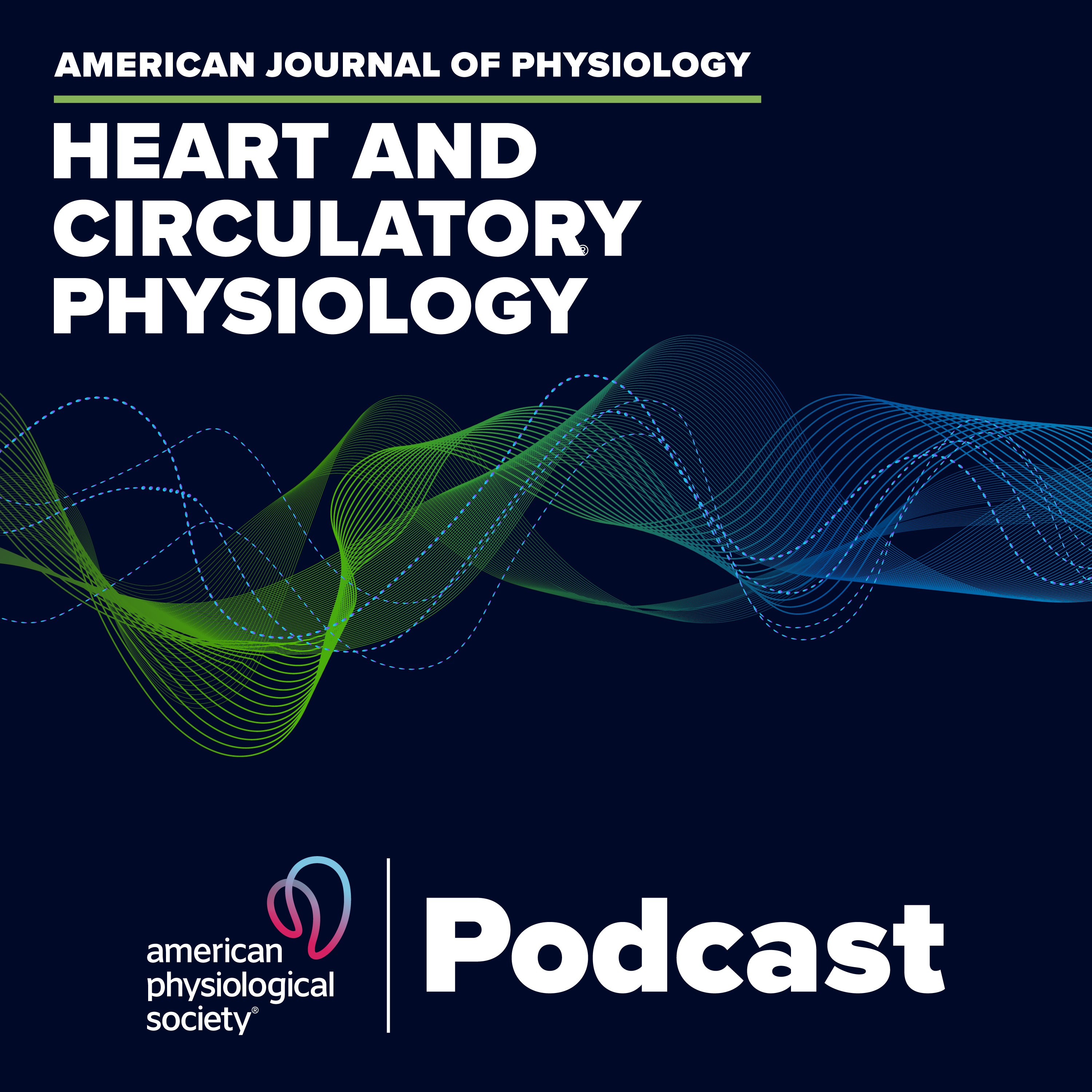Episodes

Wednesday Jul 11, 2018
Different Roles of ENaC in Carotid and Mesenteric Arteries
Wednesday Jul 11, 2018
Wednesday Jul 11, 2018
Are ENaC (Epithelial Na+ channels) sheer sensors in arteries? This is the central question we explore in our latest podcast, as Associate Editor Robert Hester (University of Mississippi Medical Center) and content expert Heather Drummond (University of Mississippi Medical Center) interview lead author Martin Fronius (University of Otago, New Zealand) about the intriguing new work by Ashley et al. Fronius and co-authors observed a dilation in vessel diameter in carotid arteries when ENaC was blocked. In contrast, blocking ENaC in mesenteric arteries resulted in vasoconstriction. Does the architecture of the ENaC itself, in endothelial cells compared to smooth muscle cells, affect the response to sheer stress? Listen and find out.
Zoe Ashley, Sama Mugloo, Fiona J. McDonald, and Martin Fronius Epithelial Na+ channel differentially contributes to shear stress-mediated vascular responsiveness in carotid and mesenteric arteries from mice Am J Physiol Heart Circ Physiol, published May 1, 2018. DOI: 10.1152/ajpheart.00506.2017

Tuesday Jun 26, 2018
Sex, Cycle and Contraceptive Phase on Endothelial Function
Tuesday Jun 26, 2018
Tuesday Jun 26, 2018
Is brachial artery endothelial function in healthy premenopausal women negatively impacted by longer term use of oral contraceptive pills? Listen as Guest Editor Milton H. Hamblin (Tulane University School of Medicine) interviews lead author Maureen MacDonald (McMaster University) and content expert Daniel Credeur (University of Southern Mississippi) about the novel work by Shenouda et al, which was inspired by a lack of information in the scientific literature about controlling for contraceptive pill use and menstrual cycle when assessing endothelial function in healthy humans. There are estimates that over 67 million women worldwide are using oral contraceptive pills, yet the effect of this medication on vascular endothelial and smooth muscle physiology is dramatically understudied. Does brachial artery flow mediated dilation change across the menstrual cycle in healthy women? How do these results compare to men? Listen, read, and find out.
Ninette Shenouda, Stacey E. Priest, Vanessa I. Rizzuto, and Maureen J. MacDonald Brachial artery endothelial function is stable across a menstrual and oral contraceptive pill cycle, but lower in premenopausal women than age-matched men Am J Physiol Heart Circ Physiol, published May 4, 2018. DOI: 10.1152/ajpheart.00102.2018

Monday Jun 04, 2018
Preclinical Echocardiography: Training and Guidelines
Monday Jun 04, 2018
Monday Jun 04, 2018
Given the current conversations around rigor and reproducibility, and the need to reinforce scientific research to the public, our latest podcast is particularly timely. Deputy Editor Merry Lindsey (University of Mississippi Medical Center) interviews lead author Daniel Donner (Baker Heart and Diabetes Institute) and content expert Lisandra de Castro Bras (East Carolina University) about the unique study by Donner and colleagues focused on standardizing the quality of echocardiography in mice at Baker Heart and Diabetes Institute, Melbourne, Australia. Listen as we address the importance of consistent training for echocardiography readers on the analysis of echocardiographic images. Did Donner and co-authors find that implementing a short, formal preclinical echo training program at Baker Heart and Diabetes was as onerous as they originally anticipated? Power analysis in the study by Donner et al revealed that sample sizes needed to detect differences were reduced more than 50% after training. What are the implications of reductions in sample size on improving methodology, reducing animal numbers, and reducing research costs? Listen now.
Daniel G. Donner, Helen Kiriazis, Xiao-Jun Du, Thomas H. Marwick, and Julie R. McMullen Improving the quality of preclinical research echocardiography: Observations, training and guidelines for measurement Am J Physiol Heart Circ Physiol, published online April 20, 2018 DOI: 10.1152/ajpheart.00157.2018

Friday May 25, 2018
MicroRNA Translocation into the Mitochondria
Friday May 25, 2018
Friday May 25, 2018
In this podcast, we explore the exciting field of mitochondrial transcriptomics. Guest Editor John Hollander (West Virginia University School of Medicine) interviews lead author Samarjit Das (Johns Hopkins University) and content expert Paras Mishra (University of Nebraska Medical Center) about the new Review by Anne Macgregor-Das and Samarjit Das which expands our understanding of the intersection between mitochondria and non-coding RNAs. The mitochondrial genome only contains 13 protein encoding genes. Questions abound: Why are so many microRNAs found in the mitochondria, and do they all bind to mitochondrial mRNAs? What percentage of mitomereres are directly involved in the regulation of the mitochondrial genome? What diseases do our experts envision benefitting from microRNA therapeutics in the near future? Listen to find the answers.
Anne M. Macgregor-Das and Samarjit Das A microRNA's Journey to the Center of the Mitochondria Am J Physiol Heart Circ Physiol, published March 23, 2018. DOI: 10.1152/ajpheart.00452.2017

Thursday May 24, 2018
Exercise Training Increases GCH1 and Couples eNOS in Heart Failure
Thursday May 24, 2018
Thursday May 24, 2018
What is the mechanisms for the beneficial effects of exercise on coronary artery function in heart failure? Associate Editor Nancy Kanagy (University of New Mexico School of Medicine) interviews lead author Luciana Venturini Rossoni (University of Sao Paulo Biomedical Sciences Institute) and content expert Shane Phillips (University of Illinois-Chicago) about the fascinating new work by Couto et al in this engaging podcast. What mechanisms mediate the beneficial effects of aerobic exercise after heart failure? What role does tetrahydrobiopterin play in restoring coronary artery dilatory function? Listen and find out.
Gisele K. Couto, Suliana M. Paula, Igor L. Gomes-Santos, Carlos Eduardo Negrão, and Luciana V. Rossoni Exercise training induces eNOS coupling and restores relaxation in coronary arteries of heart failure rats Am J Physiol Heart Circ Physiol, published April 9, 2018. DOI: 10.1152/ajpheart.00624.2017

Friday Mar 23, 2018
Guidelines for Experimental Models of Myocardial Ischemia and Infarction
Friday Mar 23, 2018
Friday Mar 23, 2018
Myocardial infarction is a global health problem, and accordingly, treatment and prevention are the focus of a significant number of basic cardiovascular research projects. Animal models of myocardial ischemia, with or without reperfusion, are commonly used to study myocardial infarction, but with little guidance on best practices. Enter our new Guidelines in Cardiovascular Research article on “Guidelines for Experimental Models of Myocardial Ischemia and Infarction,” the result of a year-long collaboration of 20 internationally-recognized experts. Listen as Editor in Chief Irving H. Zucker (University of Nebraska Medical Center) interviews authors Merry Lindsey (University of Mississippi Medical Center), Gerd Heusch (Universitatsklinikum Essen), Karyn Przyklenk (Wayne State University School of Medicine), Elizabeth G. Murphy (NIH, National Heart, Lung, and Blood Institute), and Steven P. Jones (University of Louisville) about this comprehensive work establishing guidelines for rigor and reproducibility when using ischemia models. Strengths and limitations of a wide-range of specific models are analyzed, and the authors provide a veritable checklist for animal usage, study design, and experimental procedures. The authors also list data output details, in particular for in vivo studies, in easy-to-read table format. Listen as we unpack this landmark Guidelines in Cardiovascular Research article in this engaging conversation with key leaders in the field.
Merry L. Lindsey, Roberto Bolli, John M. Canty, Xiao-Jun Du, Nikolaos G. Frangogiannis, Stefan Frantz, Robert G. Gourdie, Jeffrey W. Holmes, Steven P. Jones, Robert Kloner, David J. Lefer, Ronglih Liao, Elizabeth Murphy, Peipei Ping, Karin Przyklenk, Fabio A. Recchia, Lisa Schwartz Longacre, Crystal May Ripplinger, Jennifer E Van Eyk, and Gerd Heusch Guidelines for Experimental Models of Myocardial Ischemia and Infarction Am J Physiol Heart Circ Physiol, published January 12, 2018. DOI: doi/10.1152/ajpheart.00335.2017

Tuesday Mar 13, 2018
Guidelines for Measuring Cardiac Physiology in Mice
Tuesday Mar 13, 2018
Tuesday Mar 13, 2018
With increased focus on rigor and reproducibility in basic science, is now the best time to set the record straight on measuring cardiac physiology in mice? Yes, according to five experts who collaborated to write new comprehensive Guidelines in Cardiovascular Research on this vitally important topic. Listen as Consulting Editor David A. Kass (Johns Hopkins University School of Medicine) interviews co-authors Merry Lindsey (University of Mississippi Medical Center), Zamaneh Kassiri (University of Alberta, Canada), Jitka Virag (East Carolina University), Lisandra E. de Castro Bras (East Carolina University), and Marielle Scherrer-Crosbie (Hospital of the University of Pennsylvania). The authors discuss the strengths and limitations of various imaging modalities used to evaluate cardiac physiology, as well as their extensive literature analysis which led to the development of a checklist for authors and reviewers of minimum cardiac physiology information to be included in manuscript methods. In addition to echocardiography, echo Doppler, and MRI, what would these experts like to see developed for a “toolbox of the future”? Listen and find out.
Merry L. Lindsey, Zamaneh Kassiri, Jitka Amira Ismail Virag, Lisandra E. de Castro Bras, and Marielle Scherrer-Crosbie Guidelines for Measuring Cardiac Physiology in Mice Am J Physiol Heart Circ Physiol, published January 5, 2018. DOI: doi/10.1152/ajpheart.00339.2017

Wednesday Mar 07, 2018
Temporal Dynamics of Acute and Chronic Heart Failure
Wednesday Mar 07, 2018
Wednesday Mar 07, 2018
What are the pathophysiological changes after myocardial infarction that effect the left ventricle, spleen, and kidney? Listen as Deputy Editor Merry Lindsey (University of Mississippi Medical Center) interviews lead author Ganesh Halade (University of Alabama at Birmingham) and content expert Zamaneh Kassiri (University of Alberta, Canada) about the novel study by Halade and co-authors which catalogued the time-dependent myocardial damage nexus to cardiosplenic and cardiorenal networks in heart failure pathology. The authors took a unique bedside-to-bench approach in their animal model study, inspired by the whole-body effects myocardial infarction patients experience, as MI triggers irreversible damage to the spleen and kidneys. With references to the new guidelines on ischemia and infarction models in animal experiments and to the push for increased rigor and reproducibility in basic science research, this podcast is a “must-listen” episode!
Ganesh V. Halade, Vasundhara Kain, and Kevin. A. Ingle Heart functional and structural compendium of cardiosplenic and cardiorenal networks in acute and chronic heart failure pathology Am J Physiol Heart Circ Physiol, published February 1, 2018. DOI: 10.1152/ajpheart.00528.2017

Thursday Feb 08, 2018
mTOR Prevents Ferroptosis in Cardiomyocytes
Thursday Feb 08, 2018
Thursday Feb 08, 2018
What differentiates ferroptosis in the heart from apoptosis and necrosis? Listen as Deputy Editor Merry Lindsey (University of Mississippi Medical Center) interviews lead author Takashi Matsui (University of Hawai'i) and content expert Lorrie Kirshenbaum (St. Boniface General Hospital Research Centre, Canada) about the exciting new study by Baba et al, one of the first to show that ferroptosis is distinct from autophagy, apoptosis and necrosis in cardiomyocytes. Ferroptosis is cell death characterized by excessive levels of iron and to iron-mediated reactive oxygen species generation. Did the authors find that glutathione peroxidase 4 (GPX4) played a role in cardiomyocyte ferroptosis? What connection did the authors find between the mTor pathway and iron-mediated cell death in cardiomyocytes? Listen, read, and view the beautiful cardiomyocyte isolation images to learn more.
Yuichi Baba, Jason K Higa, Briana K Shimada, Kate M. Horiuchi, Tomohiro Suhara, Motoi Kobayashi, Jonathan D. Woo, Hiroko Aoyagi, Karra S Marh, Hiroaki Kitaoka, and Takashi Matsui Protective Effects of the Mechanistic Target of Rapamycin against Excess Iron and Ferroptosis in Cardiomyocytes Am J Physiol Heart Circ Physiol, published November 10, 2017. DOI: 10.1152/ajpheart.00452.2017

Tuesday Feb 06, 2018
Guidelines on Antibody Use in Physiology Studies
Tuesday Feb 06, 2018
Tuesday Feb 06, 2018
It is nearly impossible to avoid using antibodies in biological research, but are cardiovascular researchers validating reagents the right way? In our latest podcast on Guidelines in Cardiovascular Research, Editor in Chief Irving H. Zucker (University of Nebraska Medical Center) interviews authors Heddwen L. Brooks (University of Arizona) and Deputy Editor Merry L. Lindsey (University of Mississippi Medical Center), along with expert John Hollander (West Virginia University School of Medicine) about how best to advise researchers on antibody use in immunohistochemistry and immunoblotting for evaluating expression of specific proteins in the cells and tissues of interest. Given the ongoing call for increased rigor and reproducibility in scientific research, this Guidelines article podcast offers investigators a roadmap to what controls should be performed and what information should be recorded when using antibodies in cardiovascular physiology research. Listen now.
Heddwen L Brooks and Merry L. Lindsey Guidelines for Authors and Reviewers on Antibody Use in Physiology Studies Am J Physiol Heart Circ Physiol, published January 5, 2018. DOI: 10.1152/ajpheart.00512.2017

